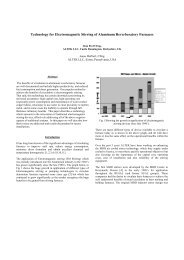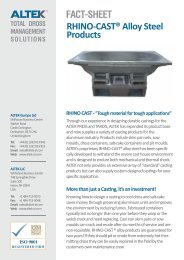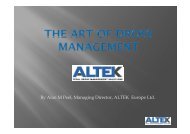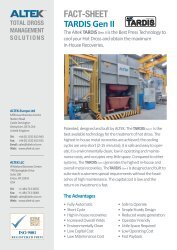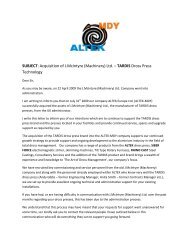Control of Melt Loss in the Aluminium Cast House By: Alan ... - ALTEK
Control of Melt Loss in the Aluminium Cast House By: Alan ... - ALTEK
Control of Melt Loss in the Aluminium Cast House By: Alan ... - ALTEK
Create successful ePaper yourself
Turn your PDF publications into a flip-book with our unique Google optimized e-Paper software.
<strong>Control</strong> <strong>of</strong> <strong>Melt</strong> <strong>Loss</strong> <strong>in</strong> <strong>the</strong> Alum<strong>in</strong>ium <strong>Cast</strong> <strong>House</strong><br />
<strong>By</strong>: <strong>Alan</strong> M Peel – <strong>ALTEK</strong>-EUROPE Ltd, UK<br />
Abstract<br />
While it is generally acknowledged that dross generation should be kept to a m<strong>in</strong>imum <strong>in</strong> <strong>the</strong><br />
cast house, too <strong>of</strong>ten, <strong>the</strong> importance to maximize <strong>the</strong> alum<strong>in</strong>ium content <strong>of</strong> <strong>the</strong> dross is<br />
overlooked. Some mistakenly believe that a low metal content is a good th<strong>in</strong>g and that <strong>the</strong><br />
alum<strong>in</strong>ium is be<strong>in</strong>g kept <strong>in</strong> <strong>the</strong> furnace. In reality, this metal is most likely be<strong>in</strong>g lost due to<br />
<strong>in</strong>sufficient cool<strong>in</strong>g and <strong>the</strong>rmit<strong>in</strong>g.<br />
Much can be gleaned from look<strong>in</strong>g at <strong>the</strong> dross that is generated <strong>in</strong> a casthouse; <strong>in</strong> fact, <strong>the</strong><br />
quality <strong>of</strong> dross can provide a good <strong>in</strong>dication <strong>of</strong> <strong>the</strong> overall efficiency <strong>of</strong> <strong>the</strong> cast house operation.<br />
Even with low alum<strong>in</strong>ium prices a reduction <strong>in</strong> dross generation with<strong>in</strong> <strong>the</strong> furnace can provide<br />
huge sav<strong>in</strong>gs per year. Effective dross management also results <strong>in</strong> better metal quality, improved<br />
fuel efficiency, prolonged refractory life and improved yield <strong>in</strong> <strong>the</strong> entire facility.<br />
However we need to remember that dross is a ‘by product’ <strong>of</strong> melt oxidation. There are many<br />
activities with<strong>in</strong> <strong>the</strong> cast house that can give rise to melt loss and <strong>the</strong> consequent dross formation<br />
and we will look specifically at <strong>the</strong> activities <strong>in</strong> <strong>the</strong> furnace with<strong>in</strong> <strong>the</strong> context <strong>of</strong> this paper and also<br />
how certa<strong>in</strong> actions immediately follow<strong>in</strong>g skimm<strong>in</strong>g will assist <strong>in</strong> <strong>in</strong>creas<strong>in</strong>g <strong>the</strong> metal recovery<br />
from <strong>the</strong> dross.<br />
In summary by careful attention to <strong>the</strong> equipment and process techniques around <strong>the</strong> furnace<br />
and <strong>the</strong> follow on dross management post skimm<strong>in</strong>g, significant cost sav<strong>in</strong>gs and environmental<br />
benefits can be realized by cast house operations.<br />
INTRODUCTION<br />
<strong>Melt</strong> loss comes from a variety <strong>of</strong> sources with<strong>in</strong> <strong>the</strong> alum<strong>in</strong>ium cast house as a consequence <strong>of</strong><br />
oxidation <strong>of</strong> <strong>the</strong> alum<strong>in</strong>ium. As was reported by Taylor [1] oxidation <strong>of</strong> a fresh liquid alum<strong>in</strong>ium<br />
surface to Al2O3 at 750 °C will occur if partial pressure <strong>of</strong> oxygen (Po2) is greater than extremely<br />
low pressures (equivalent to vacuums found <strong>in</strong> deep space !). This would suggest <strong>the</strong>refore that<br />
alum<strong>in</strong>ium would just oxidize away but it doesn’t due to <strong>the</strong> <strong>in</strong>itial th<strong>in</strong> oxide formation formed<br />
immediately alum<strong>in</strong>ium is exposed to air (oxygen) whe<strong>the</strong>r this be solid <strong>in</strong>gots, scrap generated or<br />
even <strong>the</strong> liquid alum<strong>in</strong>ium surface <strong>in</strong> <strong>the</strong> alum<strong>in</strong>ium bath <strong>in</strong> <strong>the</strong> furnace.<br />
The graph below shows <strong>the</strong> ma<strong>in</strong> causes <strong>of</strong> melt loss with<strong>in</strong> <strong>the</strong> cast house by area and as<br />
reported by Clarke and McGlade [2] when <strong>the</strong>y carried out a survey <strong>of</strong> Australian and New<br />
Zealand primary smelter by far <strong>the</strong> greatest contributor is <strong>the</strong> Furnace area contribut<strong>in</strong>g almost<br />
60% <strong>of</strong> <strong>the</strong> losses.<br />
Fig1. Graph show<strong>in</strong>g <strong>the</strong> estimated melt loss by area with<strong>in</strong> <strong>the</strong> cast house[2]<br />
<strong>Melt</strong> <strong>Loss</strong> with<strong>in</strong> <strong>the</strong> furnace<br />
When you actually look at <strong>the</strong> losses with<strong>in</strong> <strong>the</strong> furnace by activity, as shown <strong>in</strong> Figure 2 below,<br />
as found [2] through <strong>in</strong>terviews <strong>of</strong> <strong>the</strong> different plant <strong>in</strong> Australia and New Zealand, <strong>the</strong> fill<strong>in</strong>g
operation <strong>in</strong> <strong>the</strong> furnace is by far <strong>the</strong> largest contributor at 80%, assum<strong>in</strong>g <strong>the</strong> furnace is not<br />
melt<strong>in</strong>g scrap.<br />
Clearly <strong>in</strong>troduc<strong>in</strong>g scrap (and also alloys)<br />
<strong>in</strong>to <strong>the</strong> equation can change th<strong>in</strong>gs<br />
significantly also and we will briefly touch on<br />
this po<strong>in</strong>t.<br />
Fig 2. Graph show<strong>in</strong>g <strong>the</strong> estimated melt<br />
loss by activity with<strong>in</strong> <strong>the</strong> furnace.[2]<br />
The key is to avoid melt loss <strong>in</strong> <strong>the</strong> 1 st<br />
<strong>in</strong>stance and by careful attention to <strong>the</strong><br />
process techniques and technologies <strong>in</strong> <strong>the</strong><br />
furnace area and this can go a long way to<br />
m<strong>in</strong>imiz<strong>in</strong>g melt loss both dur<strong>in</strong>g <strong>the</strong> furnace<br />
cycle and immediately after skimm<strong>in</strong>g.<br />
There are several major activities that contribute to melt loss and <strong>the</strong> consequent dross<br />
generation with<strong>in</strong> <strong>the</strong> furnace as each has an effect <strong>of</strong> <strong>the</strong> oxidation process <strong>of</strong> alum<strong>in</strong>ium. As has<br />
been reported <strong>in</strong> many papers [1,4,7], <strong>the</strong> oxide sk<strong>in</strong> formed on <strong>the</strong> bath surface changes with<br />
time and is affected by many activities that <strong>the</strong>n occur with<strong>in</strong> <strong>the</strong> furnace, such as;<br />
1. Liquid metal addition (from pot l<strong>in</strong>es)<br />
2. Scrap charg<strong>in</strong>g and types <strong>of</strong> scrap addition<br />
3. Burner sett<strong>in</strong>gs and control<br />
4. Alloy additions<br />
5. Flux additions<br />
6. Stirr<strong>in</strong>g techniques<br />
7. Skimm<strong>in</strong>g practice<br />
8. Furnace bath temperature control<br />
Technologies for reduc<strong>in</strong>g oxidation, dross generation<br />
Opportunities for reduc<strong>in</strong>g melt loss and dross generation can come <strong>in</strong> a multitude <strong>of</strong> areas<br />
depend<strong>in</strong>g on <strong>the</strong> generators exist<strong>in</strong>g technology and practices. It should be recognized that<br />
furnace design, burner location and type all can have a major <strong>in</strong>fluence on dross generation and<br />
<strong>the</strong> appropriate style <strong>of</strong> furnace should be selected for <strong>the</strong> particular scrap types that will be<br />
melted or re-cycled, and this is relevant for <strong>the</strong> re-melt operation <strong>the</strong> re-cycler and <strong>the</strong> primary<br />
cast house alike. Furnace and burner designs are a topic <strong>in</strong> <strong>the</strong>ir own right and it is not <strong>the</strong><br />
<strong>in</strong>tention <strong>of</strong> <strong>the</strong> author to provide an <strong>in</strong>-depth review on this subject with<strong>in</strong> this paper.<br />
From review<strong>in</strong>g <strong>the</strong> analysis <strong>of</strong> major melt loss contributors described <strong>in</strong> <strong>the</strong> f<strong>in</strong>d<strong>in</strong>gs by Clark and<br />
McGlade [3], it is <strong>in</strong>terest<strong>in</strong>g to look at possible solutions and technologies to consider <strong>in</strong> order to<br />
m<strong>in</strong>imise melt loss.<br />
Siphon<strong>in</strong>g<br />
In primary smelters <strong>the</strong> method by which <strong>the</strong> liquid alum<strong>in</strong>ium is added to <strong>the</strong> cast<strong>in</strong>g furnaces<br />
has <strong>the</strong> largest potential affect on melt loss as discussed earlier. In a situation where liquid is<br />
poured <strong>in</strong>to <strong>the</strong> furnace through a pour<strong>in</strong>g spout <strong>in</strong> <strong>the</strong> side <strong>of</strong> <strong>the</strong> furnace, <strong>the</strong> cascad<strong>in</strong>g and<br />
turbulence effect created by pour<strong>in</strong>g <strong>the</strong> liquid alum<strong>in</strong>ium generates a significant amount <strong>of</strong> Al2O3.<br />
The normal protective layer that encapsulates <strong>the</strong> fresh liquid alum<strong>in</strong>ium, does not exist, and this<br />
layer is cont<strong>in</strong>ually be<strong>in</strong>g broken and <strong>the</strong> oxides be<strong>in</strong>g wrapped and mixed with<strong>in</strong> <strong>the</strong> alum<strong>in</strong>ium<br />
caus<strong>in</strong>g a significant amount <strong>of</strong> dross. It is reported that [3] that this type <strong>of</strong> liquid metal addition<br />
through pour<strong>in</strong>g (and <strong>the</strong> greater <strong>the</strong> distance <strong>the</strong> worse <strong>the</strong> effect), can contribute between 0.8%<br />
and 2% <strong>of</strong> metal loss <strong>of</strong> <strong>the</strong> metal be<strong>in</strong>g transferred.
Not only do you see a larger amount <strong>of</strong><br />
dross generation <strong>in</strong> <strong>the</strong> furnace as a<br />
consequence <strong>of</strong> this but <strong>the</strong> area around <strong>the</strong><br />
pour<strong>in</strong>g spout very quickly becomes built up<br />
with dross caus<strong>in</strong>g <strong>the</strong> covers or ‘hatch’ to<br />
not work effectively.<br />
Siphon<strong>in</strong>g when add<strong>in</strong>g liquid to <strong>the</strong> furnace<br />
is a very efficient way <strong>of</strong> m<strong>in</strong>imiz<strong>in</strong>g melt<br />
loss <strong>in</strong> a smelter’s cast<strong>in</strong>g furnace.<br />
Fig 3 – Typical Smelter Siphon system <strong>in</strong><br />
operation [3]<br />
It is suggested that siphon<strong>in</strong>g can reduce<br />
<strong>the</strong> melt loss <strong>in</strong> a furnace by as much as<br />
75% [3] <strong>in</strong> a primary smelter cast<strong>in</strong>g furnace<br />
operation. Figure 3 below shows a typical<br />
siphon operation.<br />
Scrap Type and Quality<br />
There is an old rule <strong>in</strong> <strong>the</strong> alum<strong>in</strong>um <strong>in</strong>dustry that for every 1% <strong>of</strong> contam<strong>in</strong>ation charged <strong>in</strong>to<br />
a melt<strong>in</strong>g furnace, <strong>the</strong>re will be at least an equivalent 1% melt loss [2]. The scrap type and<br />
makeup will <strong>the</strong>refore make a significant difference with regard to dross generation. While it is not<br />
always possible to choose <strong>the</strong> type <strong>of</strong> scrap that is charged <strong>in</strong>to <strong>the</strong> furnace, it should be<br />
recognized that <strong>the</strong> level <strong>of</strong> contam<strong>in</strong>ation (water, oil, pa<strong>in</strong>t, plastic, dirt, etc.) will h<strong>in</strong>der <strong>the</strong><br />
melt<strong>in</strong>g process and reduce <strong>the</strong> recovery <strong>of</strong> metal that is present. This paper does not <strong>in</strong>tend to<br />
discuss <strong>the</strong> methods <strong>of</strong> scrap preparation and <strong>the</strong>re are many reference papers that have<br />
discussed this <strong>in</strong> greater detail.<br />
Scrap size and surface area to weight also have a huge effect on melt loss if not charged <strong>in</strong> <strong>the</strong><br />
correct way. Charg<strong>in</strong>g clean, loose scalp<strong>in</strong>g chip or saw<strong>in</strong>g chips <strong>in</strong>to <strong>the</strong> bath will almost<br />
certa<strong>in</strong>ly lose a huge proportion <strong>of</strong> <strong>the</strong> alum<strong>in</strong>ium content <strong>of</strong> that scrap and this type <strong>of</strong> scrap<br />
should be charged away from burner imp<strong>in</strong>gement us<strong>in</strong>g vortex type technologies or similar.<br />
Alloy<strong>in</strong>g<br />
Alloy<strong>in</strong>g <strong>the</strong> furnace can also have a big impact on melt loss and dross generation. Certa<strong>in</strong> allows<br />
as is well known such as Al-Mg and as reported by Taylor [xxx] have a higher probability <strong>of</strong> more<br />
oxide film growth and thicken<strong>in</strong>g compared to pure alum<strong>in</strong>ium alloys.<br />
The addition <strong>of</strong> such alloys <strong>in</strong>to <strong>the</strong> furnace becomes very important [7] to m<strong>in</strong>imize such alloy<br />
metal losses and fur<strong>the</strong>r dross generation with<strong>in</strong> <strong>the</strong> furnace.<br />
Furnace Charg<strong>in</strong>g<br />
Charg<strong>in</strong>g a furnace is <strong>the</strong> next important step <strong>in</strong> control <strong>of</strong> <strong>the</strong> dross generation. It is always<br />
an advantage to be able to submerge lighter scrap directly under <strong>the</strong> molten metal. Depend<strong>in</strong>g<br />
on <strong>the</strong> types <strong>of</strong> scrap and <strong>the</strong> furnace be<strong>in</strong>g utilized, this is not always possible; however, as a<br />
general rule, light scrap should be protected from direct burner imp<strong>in</strong>gement.<br />
Burner Technology and Burner <strong>Control</strong><br />
The selection and type <strong>of</strong> burners used <strong>in</strong> a furnace and <strong>the</strong>ir control dur<strong>in</strong>g <strong>the</strong> cycle is very<br />
important and <strong>the</strong>re is <strong>of</strong>ten a f<strong>in</strong>e balance between provid<strong>in</strong>g sufficient heat transfer to meet <strong>the</strong><br />
demands <strong>of</strong> production while at <strong>the</strong> same time m<strong>in</strong>imiz<strong>in</strong>g oxidation <strong>of</strong> <strong>the</strong> metal.
All burners will produce some quantity <strong>of</strong> dross which will be generated from one <strong>of</strong> two<br />
sources; direct imp<strong>in</strong>gement <strong>of</strong> <strong>the</strong> flame with ei<strong>the</strong>r <strong>the</strong> charge or <strong>the</strong> molten metal or, from <strong>the</strong><br />
creation <strong>of</strong> hot spots below <strong>the</strong> flame on <strong>the</strong> molten metal surface. The area directly below a<br />
burner can be subject to overheat<strong>in</strong>g and wick<strong>in</strong>g <strong>of</strong> <strong>the</strong> molten metal <strong>in</strong>to surface dross, this<br />
generates fur<strong>the</strong>r oxidation and thus more dross. The <strong>in</strong>crease <strong>in</strong> dross buildup <strong>in</strong>sulates <strong>the</strong><br />
metal from <strong>the</strong> heat and will require harder fir<strong>in</strong>g; this will aga<strong>in</strong> generate more dross. It’s a<br />
vicious cycle!<br />
As previously stated, movement <strong>of</strong> <strong>the</strong> molten metal through stirr<strong>in</strong>g will also help prevent<br />
<strong>the</strong>se hot spots.<br />
Furnace Skimm<strong>in</strong>g<br />
Skimm<strong>in</strong>g removes most <strong>of</strong> <strong>the</strong> dross from <strong>the</strong> furnace allow<strong>in</strong>g for more efficient melt<strong>in</strong>g and<br />
temperature control. When and how to skim is very important and will affect <strong>the</strong> overall<br />
alum<strong>in</strong>ium recovery that is experienced from dross that is removed. Tim<strong>in</strong>g is everyth<strong>in</strong>g,<br />
skimm<strong>in</strong>g too late can cause dross to build up, reduc<strong>in</strong>g melt<strong>in</strong>g efficiency and caus<strong>in</strong>g<br />
overheat<strong>in</strong>g <strong>of</strong> <strong>the</strong> molten surface which ultimately generates more dross.<br />
Traditionally, forklift trucks equipped with homemade tools are used <strong>in</strong> <strong>the</strong> alum<strong>in</strong>um <strong>in</strong>dustry<br />
to carry out rout<strong>in</strong>e furnace operations such as skimm<strong>in</strong>g and clean<strong>in</strong>g. While functional, <strong>the</strong><br />
results are <strong>in</strong>consistent and reliant on <strong>the</strong> judgment and skill <strong>of</strong> <strong>the</strong> operator. Improper skimm<strong>in</strong>g<br />
technique can pull a significant amount <strong>of</strong> alum<strong>in</strong>um out <strong>of</strong> <strong>the</strong> furnace. It is far more economical<br />
to keep as much <strong>of</strong> <strong>the</strong> alum<strong>in</strong>ium <strong>in</strong> <strong>the</strong> furnace than it is to remove it with <strong>the</strong> dross and recover<br />
it <strong>in</strong> o<strong>the</strong>r ways.<br />
Dedicated furnaces skimm<strong>in</strong>g mach<strong>in</strong>es can provide a far more economical solution to <strong>the</strong><br />
traditional forklift truck. Such systems are specifically designed for <strong>the</strong> arduous casthouse<br />
environment and have a useful life <strong>in</strong> excess <strong>of</strong> 10 years. Precise control is possible with such<br />
technology enabl<strong>in</strong>g <strong>the</strong> operator to m<strong>in</strong>imize <strong>the</strong> amount <strong>of</strong> metal removed from <strong>the</strong> furnace.<br />
To Flux or not to Flux<br />
Fluxes are used for a variety <strong>of</strong> purposes <strong>in</strong> <strong>the</strong> alum<strong>in</strong>ium melt<strong>in</strong>g and hold<strong>in</strong>g furnaces <strong>the</strong>re<br />
is much debate and op<strong>in</strong>ion however on whe<strong>the</strong>r to use fluxes <strong>in</strong> <strong>the</strong> reverbatory melt<strong>in</strong>g furnace<br />
or side well melt<strong>in</strong>g furnace to aid alum<strong>in</strong>ium recovery from <strong>the</strong> dross. In general, a flux is<br />
typically used to separate <strong>the</strong> oxides and dirt from <strong>the</strong> free metal. Exo<strong>the</strong>rmic fluxes were widely<br />
used <strong>in</strong> <strong>the</strong> past to “heat-up <strong>the</strong> dross” and make <strong>the</strong> alum<strong>in</strong>um flow back <strong>in</strong>to <strong>the</strong> bath. It is now<br />
generally recognized that <strong>the</strong> opposite actually occurs. The capillary action <strong>of</strong> <strong>the</strong> alum<strong>in</strong>um<br />
seek<strong>in</strong>g <strong>the</strong> low pressure area where <strong>the</strong> reaction is occurr<strong>in</strong>g “sucks” up <strong>the</strong> alum<strong>in</strong>um add<strong>in</strong>g<br />
additional fuel to <strong>the</strong> reaction. On <strong>the</strong> most part, endo<strong>the</strong>rmic flux<strong>in</strong>g is now generally used <strong>in</strong> <strong>the</strong><br />
<strong>in</strong>dustry although exo<strong>the</strong>rmic fluxes are still predom<strong>in</strong>antly used <strong>in</strong> Asia. Operator tra<strong>in</strong><strong>in</strong>g and<br />
understand<strong>in</strong>g <strong>of</strong> <strong>the</strong> use <strong>of</strong> flux is critical to mak<strong>in</strong>g any material achieve <strong>the</strong> <strong>in</strong>tended result.<br />
Furnace Temperature<br />
The temperature <strong>of</strong> <strong>the</strong> metal is <strong>the</strong> s<strong>in</strong>gle most important controllable factor that determ<strong>in</strong>es<br />
<strong>the</strong> level <strong>of</strong> dross generation <strong>in</strong> a furnace. Once <strong>the</strong> temperature <strong>of</strong> <strong>the</strong> metal exceeds 782°C,<br />
dross generation <strong>in</strong>creases exponentially [6] as shown <strong>in</strong> Figure 4.
When <strong>the</strong> molten metal temperature is not<br />
properly regulated, dross can beg<strong>in</strong> to<br />
<strong>the</strong>rmite. Any time a <strong>the</strong>rmite reaction<br />
occurs, metal units are be<strong>in</strong>g lost and thus<br />
every very effort should be made to prevent<br />
this from occurr<strong>in</strong>g. The fuel <strong>in</strong> a <strong>the</strong>rmite<br />
reaction is <strong>the</strong> alum<strong>in</strong>um; <strong>the</strong> excessive<br />
temperatures generated by this reaction can<br />
cause <strong>the</strong> surface temperature <strong>of</strong> <strong>the</strong> molten<br />
bath to <strong>in</strong>crease rapidly above <strong>the</strong> 782 O C<br />
mark caus<strong>in</strong>g fur<strong>the</strong>r oxidation <strong>of</strong> <strong>the</strong><br />
surround<strong>in</strong>g metal.<br />
Fig.4 [3] Dross Generation<br />
In addition to excessive metal loss, <strong>the</strong>rmite reactions can cause damage to refractory,<br />
shorten<strong>in</strong>g <strong>the</strong> life <strong>of</strong> <strong>the</strong> furnace l<strong>in</strong><strong>in</strong>g.<br />
As we know <strong>the</strong> predom<strong>in</strong>ant heat transfer mode from <strong>the</strong> combustion space <strong>in</strong> a furnace to <strong>the</strong><br />
surface <strong>of</strong> <strong>the</strong> alum<strong>in</strong>um bath is via radiation, and because <strong>the</strong> alum<strong>in</strong>um bath is opaque, <strong>the</strong>n <strong>the</strong><br />
predom<strong>in</strong>ant mode <strong>of</strong> heat transfer from <strong>the</strong> bath surface to <strong>the</strong> bath itself is via convection and<br />
conduction.<br />
To illustrate <strong>the</strong> heat transfer dependency between <strong>the</strong> combustion space and <strong>the</strong> bath, where<br />
heat is supplied to <strong>the</strong> bath surface by a chemical flame and <strong>the</strong> dom<strong>in</strong>ant heat transfer mode <strong>in</strong><br />
<strong>the</strong> furnace is <strong>the</strong> <strong>the</strong>rmal radiation. The <strong>the</strong>rmal radiation rays are transferred both directly from<br />
<strong>the</strong> flame (combustion gases), and from <strong>the</strong> heated refractory walls.<br />
This l<strong>in</strong>k between <strong>the</strong> various furnace zones and physics are fur<strong>the</strong>r complicated by <strong>the</strong> fact that<br />
<strong>the</strong> alum<strong>in</strong>um bath surface heat transfer characteristics change with time, furnace oxidiz<strong>in</strong>g<br />
atmosphere, amount <strong>of</strong> heat transferred to <strong>the</strong> bath surface, and amount <strong>of</strong> impurity <strong>in</strong> <strong>the</strong><br />
charged scrap (if any). These changes <strong>in</strong> <strong>the</strong> heat transfer characteristics are triggered by a<br />
chemical change <strong>in</strong> <strong>the</strong> composition <strong>of</strong> <strong>the</strong> alum<strong>in</strong>um bath at <strong>the</strong> bath surface layers. This<br />
chemical change is commonly known as alum<strong>in</strong>um oxidation or dross layer formation. As is well<br />
known this oxidized layer, despite <strong>the</strong> fact it is th<strong>in</strong> <strong>in</strong> its size, impacts on <strong>the</strong> heat transfer to <strong>the</strong><br />
bath significantly, and at its extreme can cause significant reduction to <strong>the</strong> furnace overall <strong>the</strong>rmal<br />
efficiency and even damage to <strong>the</strong> furnace refractory due to overheat<strong>in</strong>g.<br />
Dur<strong>in</strong>g <strong>the</strong> melt<strong>in</strong>g cycle (<strong>in</strong> a scrap melt<strong>in</strong>g furnace) <strong>the</strong> surface temperatures and <strong>the</strong> factors<br />
def<strong>in</strong><strong>in</strong>g <strong>the</strong> heat transfer to <strong>the</strong> bath change cont<strong>in</strong>uously and <strong>in</strong> a non-l<strong>in</strong>ear way. It is well<br />
known that <strong>the</strong> molten metal bath, as it circulates <strong>in</strong>side <strong>the</strong> high temperature and oxidiz<strong>in</strong>g<br />
atmosphere <strong>of</strong> <strong>the</strong> furnace, forms a th<strong>in</strong> oxide layer that covers <strong>the</strong> alum<strong>in</strong>um bath surface. This<br />
th<strong>in</strong> oxide layer (typically <strong>the</strong> first surface layer forms <strong>in</strong> milliseconds) as it grows <strong>in</strong> thickness<br />
changes completely <strong>the</strong> optical properties <strong>of</strong> <strong>the</strong> molten alum<strong>in</strong>um surface. [4]<br />
The prolonged bath surface exposure to heat causes <strong>the</strong> th<strong>in</strong> flexible oxide layer to start<br />
undergo<strong>in</strong>g a physical change from its amorphous flexible structure to <strong>the</strong> crystall<strong>in</strong>e rigid<br />
structure. Unlike <strong>the</strong> amorphous structure <strong>the</strong> crystall<strong>in</strong>e structure does not allow for flexibility <strong>in</strong><br />
its microstructure and dur<strong>in</strong>g that phase <strong>the</strong> oxide layer starts to rupture (what is called <strong>in</strong> material<br />
micro-structure as lattices slip along preferred fault l<strong>in</strong>es) and fur<strong>the</strong>r exposes more <strong>of</strong> <strong>the</strong> pure<br />
alum<strong>in</strong>um metal below to <strong>the</strong> oxidiz<strong>in</strong>g atmosphere, and hence transform it also to oxide-alum<strong>in</strong>a<br />
(Al 2 O 3 ) <strong>in</strong> a process that is cont<strong>in</strong>uous. This transformation problem arises ma<strong>in</strong>ly when <strong>the</strong> bath<br />
receives excessive heat from <strong>the</strong> flame, and <strong>in</strong> a prolonged exposure time, with presence <strong>of</strong><br />
oxygen molecules, which is <strong>the</strong> case when <strong>the</strong> bath is stagnant <strong>in</strong> furnaces. The presence <strong>of</strong><br />
impurities (from melt<strong>in</strong>g coated and dirty scrap for example), which already have crystall<strong>in</strong>e<br />
structure, causes fur<strong>the</strong>r acceleration to this transformation process (acts as a seed for <strong>the</strong>
crystall<strong>in</strong>e transformation). Hence <strong>the</strong> oxide dross layer keeps gett<strong>in</strong>g thicker and accord<strong>in</strong>gly <strong>the</strong><br />
<strong>the</strong>rmal resistance keeps steadily <strong>in</strong>creas<strong>in</strong>g. This process <strong>of</strong> <strong>in</strong>creased <strong>the</strong>rmal resistance<br />
causes less heat dissipation <strong>in</strong>to <strong>the</strong> bath depth, which <strong>in</strong> <strong>the</strong> absence <strong>of</strong> effective circulation<br />
yields to a large temperature gradient, where <strong>the</strong> bath surface temperature is considerably higher<br />
than <strong>the</strong> bath depth. This causes a reduction <strong>in</strong> <strong>the</strong> furnace <strong>the</strong>rmal efficiency, along with<br />
refractory temperature rise.<br />
Figure 5 Bottom mounted EM Stirr<strong>in</strong>g<br />
Fig. 6 Effect <strong>of</strong> stirr<strong>in</strong>g on metal temperature<br />
As <strong>in</strong>troduced <strong>in</strong> earlier sections <strong>of</strong> this paper, stirr<strong>in</strong>g a furnace can reduce <strong>the</strong> temperature<br />
gradient between <strong>the</strong> top and bottom <strong>of</strong> <strong>the</strong> furnace <strong>in</strong> a matter <strong>of</strong> m<strong>in</strong>utes (see figure 6) and<br />
reduce dross generation by as much as 25%.<br />
There are a variety <strong>of</strong> stirr<strong>in</strong>g technologies on <strong>the</strong> market today Electromagnetic systems have<br />
<strong>in</strong>creased <strong>in</strong> popularity <strong>in</strong> <strong>the</strong> last 10 years (20 years if we consider <strong>the</strong> Japanese cast houses)<br />
and although more expensive to <strong>in</strong>stall, <strong>the</strong>re are no mov<strong>in</strong>g parts and many are non contact, so<br />
allow a non <strong>in</strong>trusive stirr<strong>in</strong>g possibility to <strong>the</strong> furnace, provid<strong>in</strong>g m<strong>in</strong>imal ma<strong>in</strong>tenance<br />
requirement and risk if failure or breakdown to <strong>the</strong> furnace operation. Permanent magnetic<br />
pumps and stirrers are a new comer to <strong>the</strong> <strong>in</strong>dustry and have been quite extensively used <strong>in</strong><br />
Ch<strong>in</strong>a and Japan dur<strong>in</strong>g <strong>the</strong> past several years. They give s<strong>in</strong>gle, directional stirr<strong>in</strong>g.<br />
In general, any form <strong>of</strong> ‘sub surface’ stirr<strong>in</strong>g technology is advantageous <strong>in</strong> help<strong>in</strong>g to reduce<br />
metal surface temperature and reduc<strong>in</strong>g dross generation. Keep<strong>in</strong>g <strong>the</strong> surface temperature as<br />
low as possible will also improve refractory life and reduce energy consumption.<br />
There are also o<strong>the</strong>r consequences to circulat<strong>in</strong>g a furnace to m<strong>in</strong>imize dross generation, <strong>the</strong><br />
positive impact it can have on energy reduction and <strong>the</strong>refore CO2 also.<br />
Impact <strong>of</strong> Circulation on energy consumption and CO2.<br />
When consider<strong>in</strong>g <strong>the</strong> use <strong>of</strong> electromagnetic stirr<strong>in</strong>g devices with<strong>in</strong> <strong>the</strong> furnace it is also<br />
important to consider <strong>the</strong> contribution that <strong>the</strong> stirrer itself adds to <strong>the</strong> energy footpr<strong>in</strong>t.<br />
As has been previously discussed at earlier conferences <strong>the</strong>re are many factors one needs to<br />
consider when choos<strong>in</strong>g <strong>the</strong> correct device for circulat<strong>in</strong>g a furnace [7]. There are several new<br />
technologies that are promot<strong>in</strong>g m<strong>in</strong>imal CO2 footpr<strong>in</strong>ts while achiev<strong>in</strong>g <strong>the</strong> significant objectives<br />
<strong>of</strong> cont<strong>in</strong>uous furnace circulation.
Figure 7 shows <strong>the</strong> air cooled side mounted EM Stirrer which has been widely adopted<br />
throughout <strong>the</strong> Russian primary <strong>in</strong>dustry over <strong>the</strong> past 15 years. Its unique design promotes very<br />
low energy consumption reported at 1 to 2 kW/tonne, based upon 40 kW power.<br />
Additional benefits are clearly <strong>the</strong> lack <strong>of</strong><br />
necessity for water, as <strong>the</strong> <strong>in</strong>ductor is air<br />
cooled provid<strong>in</strong>g lower <strong>in</strong>stallation costs and<br />
high reliability due to <strong>the</strong> solid construction<br />
<strong>of</strong> <strong>the</strong> <strong>in</strong>ductor’s coil.<br />
Figure 7 – Side Mounted EM ‘air cooled’<br />
stirrer<br />
The energy operational cost for a typical<br />
cycle at a primary cast house would <strong>the</strong>n be<br />
2 US$ per kWh per tonne<br />
Clearly capital costs, <strong>the</strong> overall TIC (Total Installed Cost) and payback calculus become<br />
important <strong>in</strong> determ<strong>in</strong><strong>in</strong>g which furnaces can justify such an <strong>in</strong>vestment. Typically any furnace that<br />
has a large proportion <strong>of</strong> scrap added or produces a high alloy product (for example 5xxx) would<br />
benefit from <strong>in</strong>vestment <strong>in</strong> Electromagnetic Stirr<strong>in</strong>g based upon production <strong>in</strong>crease (reduced<br />
cycle time, energy and dross reductions) and also <strong>the</strong> less tangiable ‘qualitive’ benefits <strong>of</strong><br />
chemical and temperature homogeneity and improved metal cleanl<strong>in</strong>ess.<br />
Additional to <strong>the</strong> energy sav<strong>in</strong>gs achieved through cont<strong>in</strong>uous circulation <strong>of</strong> melt<strong>in</strong>g and cast<strong>in</strong>g<br />
furnaces is <strong>the</strong> carbon footpr<strong>in</strong>t reduction for <strong>the</strong> cast house. <strong>By</strong> far <strong>the</strong> largest contributor to<br />
carbon emissions is energy production. Any technology that reduces energy consumption is<br />
<strong>the</strong>refore extremely advantageous.<br />
The CO2 released from energy production us<strong>in</strong>g natural gas is = 0.185 kg per kWh used [8]<br />
If we assume a conservative figure <strong>of</strong> 10% to 15% as <strong>the</strong> energy reduction from hav<strong>in</strong>g<br />
cont<strong>in</strong>uous circulation applied to <strong>the</strong> melt<strong>in</strong>g or cast<strong>in</strong>g furnace this equates to a sav<strong>in</strong>g <strong>of</strong><br />
approximately 2770kWh per furnace cycle assum<strong>in</strong>g a 50 Tonne melt<strong>in</strong>g furnace operat<strong>in</strong>g a 6<br />
hour melt cycle equipped with regenerative burners (assum<strong>in</strong>g a 550kWh/tonne efficiency).<br />
Clearly <strong>the</strong> cycle time will also reduce and it is possible to operate at a higher ro<strong>of</strong> temperature<br />
without overheat<strong>in</strong>g <strong>the</strong> surface <strong>of</strong> <strong>the</strong> bath due to <strong>the</strong> improved heat transfer.<br />
However it is not just <strong>the</strong> energy sav<strong>in</strong>g from a reduced cycle time and improved energy<br />
efficiency <strong>of</strong> <strong>the</strong> furnace due to <strong>the</strong> reasons expla<strong>in</strong>ed earlier that is important, relative to CO2<br />
contribution, one also needs to consider <strong>the</strong> impact <strong>of</strong> <strong>the</strong> stirr<strong>in</strong>g device that is used as <strong>the</strong>se<br />
devices do consume electrical energy. One <strong>the</strong>refore needs to consider <strong>the</strong> nett figure. The table<br />
below shows <strong>the</strong> impact <strong>of</strong> this.<br />
It is reported for every 1 kWh <strong>of</strong> electricity purchased it generates 0.537 kg <strong>of</strong> CO2 [8]. This<br />
supports <strong>the</strong> need to use low energy consum<strong>in</strong>g devices to achieve <strong>the</strong> energy reduction and<br />
production improvement objectives from any <strong>in</strong>vestment.<br />
If we take <strong>the</strong> follow<strong>in</strong>g assumptions we can <strong>the</strong>n assess <strong>the</strong> sav<strong>in</strong>gs that can be obta<strong>in</strong>ed on<br />
energy and CO2 contribution from furnace circulation.<br />
Assume:-<br />
50 Tonne ‘melt<strong>in</strong>g’ furnace<br />
Regenerative burners @ 550 kWh/tonne<br />
Cycle time – 6 hours (<strong>in</strong>clud<strong>in</strong>g 1 hour alloy<strong>in</strong>g/hold<strong>in</strong>g @ 200kWh)<br />
Cycles per day – 4<br />
Operat<strong>in</strong>g days per year – 330<br />
Cost <strong>of</strong> electricity - $0.10/kWh
Cost <strong>of</strong> natural gas - $0.055 per kWh<br />
EM Stirr<strong>in</strong>g (Water<br />
Cooled)<br />
EM Stirr<strong>in</strong>g (Air<br />
Cooled)<br />
Permanent Magnet<br />
Stirr<strong>in</strong>g<br />
Energy Sav<strong>in</strong>g % 10% 10% 10%<br />
Energy Sav<strong>in</strong>g per<br />
year (kWh)<br />
CO2 Sav<strong>in</strong>g per year<br />
(Kg)<br />
Energy Sav<strong>in</strong>g (US$)<br />
Operat<strong>in</strong>g Energy<br />
(Stirrer) per year<br />
(kWh) – See Note 1<br />
CO2 contribution<br />
from stirrer energy<br />
consumption<br />
3,656,400 3,656,400 3,656,400<br />
676,434 676,434 676,434<br />
201,102 201,102 201,102<br />
396,000 99,000 90,000<br />
212,652 53,163 48,330<br />
Nett CO2 sav<strong>in</strong>g 463,782 623,271 628,104<br />
Table 2 – Evaluation <strong>of</strong> CO2 impact <strong>of</strong> different Stirr<strong>in</strong>g technologies on a 50 T melt<strong>in</strong>g furnace<br />
Note 1 – Based on kWh/tonne from Table 1 above.<br />
Dross Management with<strong>in</strong> <strong>the</strong> <strong>Cast</strong> <strong>House</strong><br />
Follow<strong>in</strong>g skimm<strong>in</strong>g <strong>of</strong> <strong>the</strong> furnace, it is critical that <strong>the</strong> dross is dealt with very quickly and very<br />
efficiently to avoid any fur<strong>the</strong>r loss <strong>of</strong> <strong>the</strong> alum<strong>in</strong>ium with<strong>in</strong> <strong>the</strong> dross through burn<strong>in</strong>g. Rapid<br />
cool<strong>in</strong>g <strong>of</strong> <strong>the</strong> dross to stop any burn<strong>in</strong>g <strong>of</strong> <strong>the</strong> alum<strong>in</strong>ium and also comb<strong>in</strong>ed with pressure to<br />
allow agglomeration <strong>of</strong> <strong>the</strong> alum<strong>in</strong>ium particles with<strong>in</strong> <strong>the</strong> dross to form larger alum<strong>in</strong>ium ‘plates’,<br />
see Figure 8 below, <strong>in</strong>creases significantly <strong>the</strong> chances <strong>of</strong> higher alum<strong>in</strong>ium recovery from <strong>the</strong><br />
dross.<br />
Figure 8 – Pictures shows <strong>the</strong> effect <strong>of</strong> agglomerat<strong>in</strong>g alum<strong>in</strong>ium particles with<strong>in</strong> <strong>the</strong> dross<br />
through press<strong>in</strong>g.<br />
Figure 9 below shows <strong>the</strong> results <strong>of</strong> a study conducted at Cressona Alum<strong>in</strong>ium <strong>in</strong> <strong>the</strong> mid 1990’s<br />
compar<strong>in</strong>g various dross management techniques. It is important to recognize that <strong>the</strong>se tests<br />
were conducted us<strong>in</strong>g <strong>the</strong> same type <strong>of</strong> dross, i.e. dross from <strong>the</strong> same facility skimmed from <strong>the</strong>
same furnaces managed by <strong>the</strong> same operators. This is <strong>the</strong> only way to compare technologies.<br />
We have assumed an alum<strong>in</strong>ium price <strong>of</strong> $1400 per tonne for RSI.<br />
Fig. 9 Dross Recovery Study at Cresona Alum<strong>in</strong>ium, USA<br />
Dross Presses<br />
The Dross Press became commercially available <strong>in</strong> <strong>the</strong> early 1990’s and today <strong>the</strong>re are<br />
several manufactures that supply different versions <strong>of</strong> this technology [9]. Dross press<strong>in</strong>g<br />
technology is based on <strong>the</strong> pr<strong>in</strong>ciple that a liquid placed under pressure will separate from a solid<br />
and flow to <strong>the</strong> areas <strong>of</strong> least pressure. The press system consists <strong>of</strong> a steel frame, hydraulic<br />
unit, a press<strong>in</strong>g head and a skim pans set. Once skimmed, <strong>the</strong> dross is transferred <strong>in</strong>to <strong>the</strong> press<br />
and <strong>the</strong> head is slowly lowered. The pressure forces metal out <strong>in</strong>to <strong>the</strong> sow mold which is located<br />
under <strong>the</strong> skim pan, and agglomerates <strong>the</strong> f<strong>in</strong>e particles <strong>of</strong> alum<strong>in</strong>ium on <strong>the</strong> outside surface <strong>of</strong><br />
<strong>the</strong> dross. This encapsulates <strong>the</strong> oxides prevent<strong>in</strong>g dust<strong>in</strong>g and <strong>the</strong>rmit<strong>in</strong>g (see figure 5 below).<br />
Dross presses were <strong>the</strong> first technology to physically reshape <strong>the</strong> dross, improv<strong>in</strong>g <strong>the</strong> cast house<br />
environment and recoveries at <strong>the</strong> secondary processor. The system not only rapidly cools dross<br />
but can also provide <strong>the</strong> highest <strong>in</strong>-house dra<strong>in</strong>. Overall dross recoveries can range from 60 –<br />
70%. Two conditions where <strong>the</strong> dross press may be less effective are if <strong>the</strong> dross is too cold to<br />
press or if <strong>the</strong> dross is heavily <strong>the</strong>rmit<strong>in</strong>g. Thermit<strong>in</strong>g dross can be processed but requires<br />
revised practices, longer cycle times and special cool<strong>in</strong>g techniques.<br />
Fig. 10 Dross after press<strong>in</strong>g<br />
Fig.11 <strong>ALTEK</strong> Dross Press
CONCLUSIONS<br />
Commercial and environmental pressures will cont<strong>in</strong>ue to make <strong>the</strong> alum<strong>in</strong>ium <strong>in</strong>dustry ever more<br />
competitive. Those companies who focus on effective furnace melt loss and dross management<br />
will not only m<strong>in</strong>imize <strong>the</strong>ir unit cost <strong>of</strong> production but will also benefit from <strong>the</strong> many process and<br />
environmental advantages <strong>of</strong> a well managed casthouse. This, when done correctly, translates to<br />
a better work environment and major cost sav<strong>in</strong>gs.<br />
Focus<strong>in</strong>g on keep<strong>in</strong>g <strong>the</strong> alum<strong>in</strong>ium <strong>in</strong> <strong>the</strong> furnace and m<strong>in</strong>imiz<strong>in</strong>g melt loss is <strong>the</strong> key practice<br />
through techniques discussed above as <strong>the</strong>se not only benefit reduced metal losses but also can<br />
provide significant benefits <strong>in</strong> energy and CO2 reductions.<br />
Each stage <strong>of</strong> <strong>the</strong> alum<strong>in</strong>ium production process with<strong>in</strong> <strong>the</strong> casthouse should be carefully<br />
evaluated to determ<strong>in</strong>e <strong>the</strong> potential for improvement verses <strong>the</strong> required capital <strong>in</strong>vestment.<br />
Typically, return on <strong>in</strong>vestment for melt loss improvements and total dross management projects<br />
are extremely short s<strong>in</strong>ce metal units are extremely valuable.<br />
REFERENCES<br />
1. Taylor, J.A (2007) Oxidation, dross and melt loss issues <strong>in</strong>volved <strong>in</strong> <strong>the</strong> alum<strong>in</strong>ium cast<br />
house, Proceed<strong>in</strong>gs <strong>of</strong> Alum<strong>in</strong>ium <strong>Cast</strong> <strong>House</strong> Technology, 6-9 August 2007, Sydney,<br />
Australia, 47-55<br />
2. Clarke, A and McGlade, P. (2005) Furnace dross prevention, melt loss reduction and dross<br />
recycl<strong>in</strong>g; Review <strong>of</strong> best practice, 3 rd Inter. <strong>Melt</strong> Quality Workshop, Dubai, UAE, 14-16 th Nov<br />
2005, 8pp<br />
3. Locatelli, J and Guangwei L. (2009) Automated Metal Siphon<strong>in</strong>g and <strong>Cast</strong> <strong>House</strong> Energy<br />
Consumption, Proceed<strong>in</strong>gs <strong>of</strong> Alum<strong>in</strong>ium <strong>Cast</strong> <strong>House</strong> Technology, 13-16 September 2009,<br />
Gold Coast, Australia, 61-69<br />
4. Peel, A Alchalabi, R. and Meng, F. (2002) Furnace Operation Optimisation with EMP System,<br />
Light Metals 2002,<br />
5. Graham Guest & Richard Evans, “Ste<strong>in</strong> Atk<strong>in</strong>son Stordy Ltd, The Alum<strong>in</strong>um Decoat<strong>in</strong>g<br />
Handbook”<br />
6. Rossel, H. (1990) Fundamental <strong>in</strong>vestigations about metal loss dur<strong>in</strong>g remelt<strong>in</strong>g <strong>of</strong> extrusion<br />
and roll<strong>in</strong>g fabrication scrap, Light Metals 1990, TMS, 721-729<br />
7. Peel, A. (2003) A look at <strong>the</strong> History and Some Recent Developments <strong>in</strong> <strong>the</strong> use <strong>of</strong><br />
Electromagnetic Devices for Improv<strong>in</strong>g Operational Efficiency <strong>in</strong> <strong>the</strong> Alum<strong>in</strong>ium <strong>Cast</strong>house.<br />
8 th Australasian Alum<strong>in</strong>ium <strong>Cast</strong>house Technology Conference<br />
8. Carbon Trust – Greenhouse Gas Conversion Factors 2009<br />
9. Herbert, J. Roth, D, Coll<strong>in</strong>s, M. (2007) The Art <strong>of</strong> Dross Management – Maximis<strong>in</strong>g Dross<br />
Values and M<strong>in</strong>imis<strong>in</strong>g Dross Generation, TMS 2008



